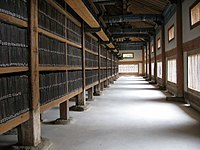Woodblock printing in Korea

The history of Woodblock printing in Korea (목판인쇄) contains a famous history like the Tripitaka Koreana.
The world's oldest surviving woodblock print is thought to be the The Great Dharani Sutra, a small Buddhist scroll discovered at Bulguksa Temple in Gyeongju, South Korea, in 1966. Scholars have deduced that it was published around 751 under the Silla Dynasty.[1]
Hisotry[edit]
Middle of the 8th century[edit]

Gakja is a Korean word that refers to the technique of engraving letters or images on a board or board. The master of this technique is called individual characters.
Korea's oldest woodcarver is the The Great Dharani Sutra, which was built in the mid-8th century. Gakja is a state-designated national treasure, along with other treasures in the tower.[2]
Goryeo[edit]
During the period of war and conflict, Goryeo recorded Buddhist ideology and culture historically. Along with Buddhism and Confucianism, Hanja have been steadily developed in Korean culture since before the common era. Buddhism, along with indigenous beliefs and Confucianism, became the most established religion among Koreans from an early age. Koreans completed it by printing it on Hanji, a paper made from the inner shell of a mulberry tree. In Korea, printing has enabled the spread of knowledge that was previously exclusive to writers.[3]
In 1232, during the Second Mongol Invasion of Korea, a 6,000-volume wooden board of the Tripitaka Koreana, carved in the early 12th century, was burned at the Buinsa in Daegu by nomadic Mongolians. For the tragic cultural and religious loss, the Goryeo people implemented the 15-year project (1236–1251) to carve the Tripitaka Koreana, a set of over 81,000 wooden printing plates.[3]
See also[edit]
References[edit]
- ^ "200 years before Gutenberg: The master printers of Koryo". UNESCO. 20 April 2023.
- ^ "[ZOOM KOREA] Gakja, the art of wooden block printing, continues to make its mark". Korea JoongAng Daily. August 4, 2022.
- ^ a b "[Visual History of Korea] Wooden block printing perfection of Tripitaka Koreana". The Korea Herald. November 13, 2021.
